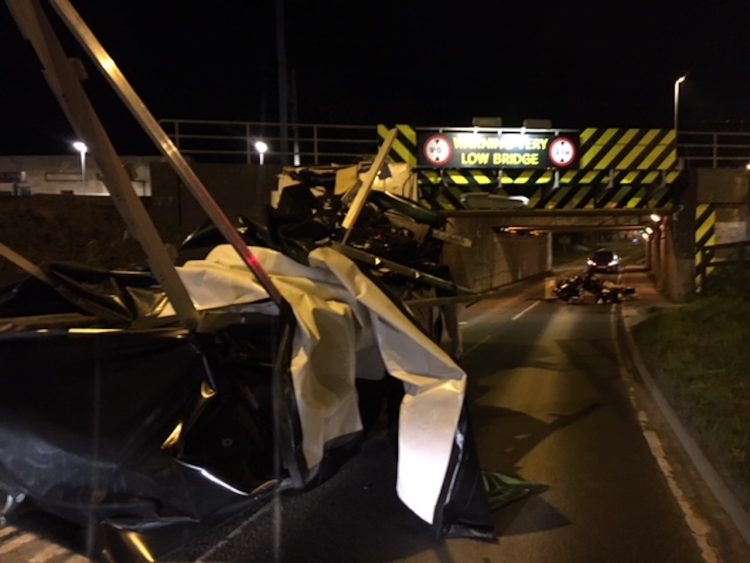With more large vehicles on Britains roads than ever, Network Rail has released a list of the most-struck rail bridges across the country
‘Wise Up, Size Up’ Is Network Rail’s ongoing campaign which aims to remind lorry drivers and haulage operators to know the height of vehicles and select suitable routes before making journeys at this especially busy time of year with both Black Friday and Christmas on the horizon.
The most bashed bridge in the country is the Stonea Road bridge on the B1098 in Cambridgeshire which was closed for 12 months in 2019 after a number of strikes before reopening in late 2020. Since reopening and for the period of April 2021 to March 2022, the bridge has been struck a shocking 33 times and has led to £10,526 of unnecessary train delays and cancellation costs. Below is the list of the most struck railway bridge in Britain for 2021/22:
- Stonea Road, Stonea, Cambridgeshire 33 strikes
- Lower Down’s Road, Wimbledon, London 18 strikes
- Harlaxton Road, Grantham, Lincolnshire 17 strikes
- Abbey Farm, Thetford, Norfolk 15 strikes
- Stuntney Road, Ely, Cambridgeshire 12 strikes
- Harefield Road, Brakespeare Road South, West Ruislip, London 12 strikes
- Station Road B4105, Berkswell, Solihull 12 strikes
- Station Road, Langley, Berkshire12 strikes
- St John’s Street, Lichfield, Staffordshire 11 strikes
- Coddenham Road, Needham Market, Suffolk 10 strikes
The ‘Wise Up, Size Up’ campaign sees a light hearted and humerous stylised animation which shows three high-sided vehicles navigating a low bridge in the oddest of ways including pole-vaulting and tunnelling beneath it. The animation aims to get a message across to drivers to take a moment to consider if it is worth taking the risk when approaching low bridges.
Network Rail works with various rail industry partners in order to deal with bridge strikes such as Highways England, the Driver and Vehicle Standards Agency or DVSA as well as hauliers. Incidents have seen a drop in recent years but a steady increasing trend has emerged which coincides with estimates of increased traffic volume. Provisional estimates by the Department for Transport from April 2021 to March 2022 have revealed that lorry traffic has increased in Great Britain by 10.1% which is equivalent to 17.8 billion vehicle miles.

Sir Peter Hendy CBE, chair of Network Rail said: “Bridge bashers cause serious safety issues on the transport network for both road and rail users. Every incident can delay tens of thousands of passengers while we inspect the bridge and repair any damage – creating a huge cost from public funds.
“During this very busy time of year for deliveries, we urge operators and drivers to properly plan their routes, know the height of their vehicles and be vigilant for road signs showing the height of bridges. We will report those who don’t to the Traffic Commissioners, and they risk losing their licenses and livelihoods. Network Rail always looks to recover the entire repair and delay costs from the driver and the operator.”
Network Rail’s ongoing 4E’s initiative focuses on education, engineering, enablement and enforcement and is part of its bid to ensure that haulage companies and their drivers have the information and tools required in order to avoid bridge strikes. The initiative sees a team of bridge strike ‘champions’ who cover each route throughout Britain and aim to raise awareness by visiting haulage companies and overseeing the management of bridge strike risk for their area.





Responses
Interesting that 7 out of 10 are to the east of the country. European drivers perhaps?
How many of these are gravity brick arch bridges, which are, of course, more difficult to judge for safe passage?
So Stonea Road in Stonea, Cambridgeshire has had more bridge strikes than at Ely before heavy goods traffic were diverted onto the newly built A142 Ely Southern bypass that opened in late October 2016.
For comparison, the infamous 11’8″ bridge (which is now actually 12’4″) gets hit about once a month, so would put it 4th-5th in the ranking above
Why can’t there be multiple red stop lights above the bridge height warning sign activated by height sensors far back enough to allow for breaking. This would at least cut down on the number of bridge strikes.
The A5 bridge in Hinckley which has topped the list in previous years has something similar, even as far back as the next roundabout so you don’t even need to block the road when you mess up. It still didn’t stop it being hit multiple times.